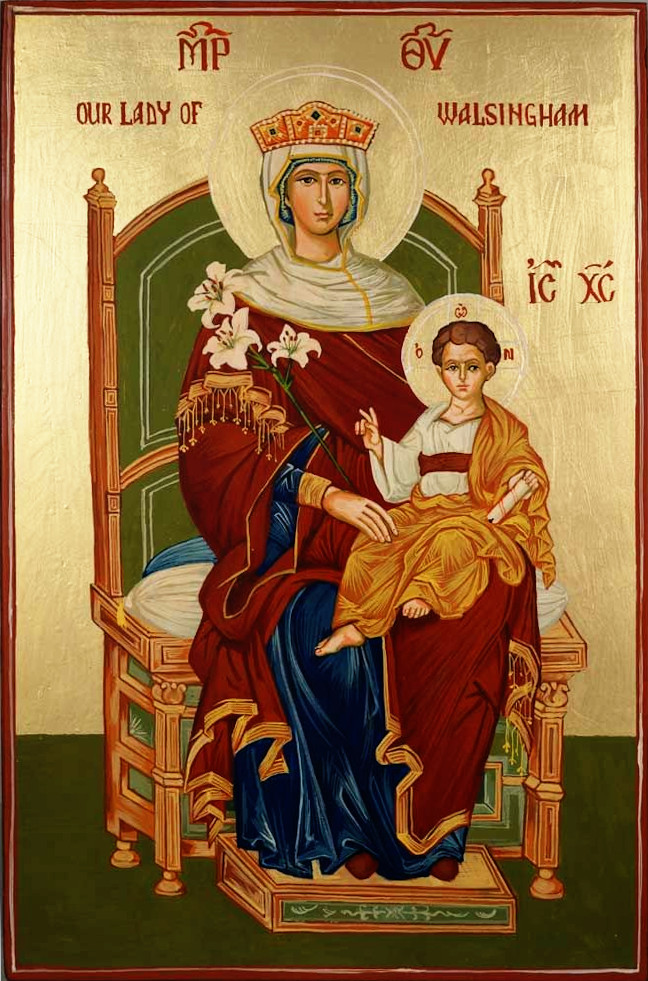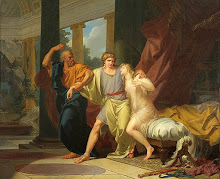The twenty-eighth of July in the Orthodox Church is the feast-day of Saint Samson of Dol, one of the great national saints of Wales alongside Saint Dewi. Surprisingly, an early Life of Saint Samson dating to the seventh century has survived – and has provided the Church with a wealth of information about Wales’s early saints. A hermit, a beloved bishop and an active and tireless missionary, Saint Samson is venerated with particular attention both in Wales and in Brittany.
Samson was born to Amon of Dyfed and his wife, Princess Anna ferch Meurig ap Tewdrig ap Llywarch of Gwent and Glywysing. He was a double cousin of Saint Maelor, whose mother was the sister of Princess Anna and whose father was the brother of Amon. Amon and Anna were happily married, and had tried for many years to have a child. For a long time, Anna like her namesake believed herself barren; so when she became pregnant it was seen as a gift from God.
Anna ferch Meurig doted on Samson, who had been named, portentiously, for the hero from the Book of Judges. His mother desired that Samson should become a priest. However, his father Amon objected for awhile to this choice, being advised by his friends that his only son should carry on the family line instead. His wife was ultimately able to win Amon over, and it was decided that they should send him, at the age of five, to study at the monastic school of Llanilltud Fawr which was being run by the holy Abbot Illtud.
Abbot Illtud, a disciple of Saint Germain of Auxerre, was a man versed backwards and forwards in both the Greek and the Hebrew Scriptures, and had been ordained priest by Saint Germain himself. As soon as the abbot saw the child Samson, he at once kissed the boy with the profound fondness of a father for his son, and gave the following prayer:
We give thanks to God, who has been so generous as to give light on earth through this lamp born of our people, unworthy though we be. Behold the noble chief of us all, behold him who is to be a high priest, to the benefit of many on this side and beyond the sea; behold the illustrious priest of all the Britons; behold the most famous of all, as a founder of churches, since the Apostles!However, when his parents asked him what he meant by this prayer, and desired to know more about Samson’s future, Saint Illtud told them that it was not his place to tell them at present. Instead, he asked that the boy be given to him to be educated. His wondering parents did so, and from then on Samson stayed at the side of Saint Illtud as though he had always been there and as though it were the most natural thing for a young boy to do. He took to reading and writing like a fish to water, and used this gift as soon as he was able, to pray from the Psalter from memory.
He also kept all the fasts that the monks kept from a very early age, and stayed up for the long vigils – even staying in the same spot for two days straight. It was up to Abbot Illtud to speak to him, sensibly, that ‘it is not appropriate, little son, that the tender body of a youth not yet matured should be broken by too many and ill-regulated fasts’. Even so, Samson was permitted to practise a strict ascetic discipline – he drank no alcohol, for example. He also practised the useful skills that the monks of Llanilltud Fawr kept, and honed them much. He became especially adept in the arts of healing. At one time a brother who had been working in the fields was bitten by a snake. Samson came over and made the sign of the Cross over the bite, then gave the brother holy water to drink, thus nullifying the poison.
Saint Dyfrig often visited Llanilltud Fawr, and he discovered Samson there, and was much impressed by the youth. He ordained Samson first a deacon, and then a priest. On both occasions, a white dove came down from heaven and lighted on Saint Samson’s shoulder. Two of Saint Illtud’s nephews, seeing the way Saint Samson was treated by the abbot and his guests, were taken with envy and tried to poison him. Saint Samson drank the poison they gave him straight down, but it had no effect on him.
Samson moved to another abbey on Caldey Island in Dyfed, which had been established by Saint Illtud’s disciple Pyro. At Caldey Samson lived simply, fasted strictly and did much manual labour. He served there as the cellarer, and then as abbot for three and a half years. Under Abbot Samson, Caldey thrived. The spiritual life of the community flourished, and Abbot Samson instructed the monks with his gentle wisdom and humility. While abbot at Caldey, word came to Samson that his father Amon had fallen gravely ill. Abbot Samson went from Caldey back to his father’s house and convinced him to come to Caldey and become a monk. Thus the father who had once opposed his son’s vows, himself took them – and was at once healed of his illness. With Amon, many of Samson’s relatives took the cowl or the veil and entered the monastic life. Samson’s uncle Saint Umbrafel and his aunt Afrelia were two of these, and so also their son Saint Magloire.
It came to pass when Abbot Samson was somewhat more advanced in years, that a few Irishmen of deep learning came to visit Caldey on their pilgrim’s road. He sought and was granted the bishop’s permission to accompany them back to Ireland. He stayed in Ireland a short while and was given the opportunity to practise his many virtues. He was deeply loved and revered by the God-fearing people who lived there. He healed the blind, cleansed those who were afflicted with leprosy, cast out devils and taught many the precepts of holy Orthodoxy, delivering them from various errors.
On his return, Abbot Samson relinquished his abbacy of Caldey and retired to a secluded cell somewhere along the banks of the Severn in western England, where he was shortly joined by Amon and two other monks. Despite Samson’s attempts to hide himself from the world, his glory could not be hidden, and many sought him out as a starets for his spiritual advice. Soon Samson retired to an even more reclusive place, a cave beside a stream, where he spent all of his time in prayer and ascetic labours.
He was approached once again by Saint Dyfrig, who appointed Samson bishop at Llanilltud Fawr in 521. Shortly before the annual feast of Saint Peter, an angel appeared to Dyfrig and told him to anoint Samson, and on the same day Saint Peter himself told Samson that he needed to accept the bishopric as the will of God. After the consecration, Saint Dyfrig and others who were present saw a stream of fire glittering in Samson’s mouth, and an angel assisting him as he presented the Gifts.
It was at this point that Saint Samson undertook a voyage to Brittany which took him through Cornwall, where he lingered for some time. He travelled all over Cornwall, healing, helping the poor and teaching the Gospel from the north to the south of the peninsula. He fasted strictly through all this time, even endangering his own health in the process. He built a monastery at Golant and another at South Hill atop an old ring of standing stones, and worked many wonders. He healed a boy who had been thrown from his horse and broke his neck. And he turned many Cornish from the worship of the Roman and Celtic gods, toward Christ. He was assisted in his work in Cornwall by two disciples who themselves became saints: Saint Austoll and Saint Mewan. He also made the acquaintance of Saint Petroc while he sojourned in Cornwall.
Saint Samson at last made his way to Brittany, but he stopped on the Isle of Guernsey in the Channel first, establishing a church there (the oldest one on the island) and converting its inhabitants to Christianity. Samson is to this day the patron saint of Guernsey, and his name still adorns a town, a harbour and a parish church on the island.
Saint Samson settled at Dol in Ille-et-Vilaine, and there founded his monastery, which served as a base for his missionary and church-founding work, which extended as far as Pental Monastery in Normandy. He also involved himself in the local politics. The Breton people had lost their legitimate king Ionas, who was murdered by a tyrannical usurper named Conomor. Samson excommunicated Conomor for this crime, and led a delegation of Bretons before the Frankish King Childebert, who was then holding Ionas’s son Iudwal in bondage, demanding that he be released so that he might take up his rightful throne. Childebert obliged him, and eventually Iudwal was able to reclaim his throne after Conomor was killed in battle against the Frankish king Lothair.
Samson also attended the local Synod of Paris in 557. He manifested the meekness and self-effacement of his personality in two ways. Firstly, he refused the luxurious lodgings that Childebert had prepared for him, instead staying at a local monastery. Secondly, when he was called to affix his name to the canons at the synod, he signed it as ‘Samson, a sinner’. He worked many wonders while he was in Brittany, including healing a woman of leprosy and her daughter of mental illness. Saint Samson lived to a venerable old age, and reposed in the Lord in his abbey at Dol on the twenty-eighth of July, 565. Holy Father Samson, venerable hermit and God-bearing ascetic, pray unto Christ that our souls may be saved!
Thy resplendent life, O holy Samson,
Enlightened all thy kindred.
They followed thee in the monastic life
And themselves became shining lights.
When consecrated Hierarch thou didst obey the heavenly vision
And build monasteries to God's glory in Brittany.
Pray to Christ our God to grant us His great mercy.














No comments:
Post a Comment